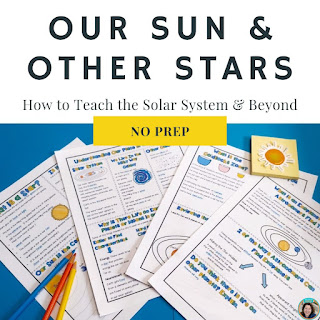Once we started talking about space, my science students inevitably had a million questions that made my head spin:
- Are there other stars in our solar system?
- Is every star a sun in another galaxy?
- Is the sun the biggest star?
- What is needed for life to exist on a planet?
With so many burning questions and exciting directions to go, I struggled with how to focus our learning.
After all, kids have so many great questions about the world beyond our planet, and the concept of space boggles the mind.
I needed concrete examples and a clear lesson plan to help solidify important concepts.
Where in the Universe to Start
With so many burning questions and exciting directions to go, I struggled with how to focus our learning. I'm not a space expert, but I love the topic (until I can't comprehend the ginormous size and my head hurts.) That's when I came up with this detailed lesson plan for teaching about our Sun, stars, solar system, and beyond to cover NGSS 5ESS1-1.
NGSS 5ESS1-1 Support an argument that differences in the apparent brightness of the sun compared to other stars is due to their relative distances from the Earth.
How to Teach About the Solar System and Beyond with Sketch Notes
One day in the teacher's lounge, I was eating my lunch and the parent of a former student and colleague of mine reflected on how her daughter excelled with the simplicity and clear layout of the class notes. This fellow teacher recalled how her daughter gained confidence with clear expectations.
Break up the four pages of sketch notes with short informational videos. My favorite videos are included with the resource including the space compilation by Crash Course for Kids. These videos along with the visual notes help students learn about our Sun, the solar system, and other stars.
These 5th-grade science sketch notes cover:
- What is a star?
- How the brightness of a star depends on its size, brightness, and distance from Earth
- If 2 stars are the same size and brightness, the closer one appears brighter
- Labeling the sun and planets in our solar system
- Fact about the sun
- Our solar system, galaxy, and other galaxies
- What is needed for life to exist on a planet
- The habitable or Goldilocks zone
- What are exoplanets?
- How astronomers find exoplanets using apparent brightness
NO PREP and So Easy to Use
Not only are these 5th-grade science sketch notes NO PREP but a slideshow is included to guide students as they fill out their notes. Complete the notes whole class and then put the slideshow in Google Classroom or your LMS for students to refer to and absent students to use as well.
Support an Argument = Writing a Scientific Explanation
How do you have students fulfill the standard to "Support an argument that differences in the apparent brightness of the sun compared to other stars is due to their relative distances from the Earth?"
A guided Claim - Evidence - Reasoning or CER writing is a great way to have students support an argument and I will walk you through it with four guided CER writing options that provide students with sentence starters. Sample answers and a grading rubric are included. This is a high level of thinking. I like to do one of the guided CERs together as a class to model and set students up for success. Then I give another CER question as an assessment.
How to Wrap Your Successful Unit with a Self-Grading Assessment
Do you want to give a printed quiz or a self-grading Google Form quiz? Both options are included. Get students ready for success with the link to a Kahoot game that you can play in class or assign for individual practice.
This ready-to-use NO PREP resource will help you teach complex topics in an easy-to-understand and visual format. Expectations are clear and students are set up for success. No headaches for you as you contemplate the vastness of our solar system, galaxy, and the universe! Be sure to check out the resource HERE.
Want to Take Your 5th Grade Science Students on a Virtual Field Trip?
One benefit from the hefty amount of online teaching and learning these last few years is the opportunity for amazing virtual field trips! Sign up with the famous Griffin Observatory that sits above Hollywood for a free virtual field trip. This resource fully prepares students for Module 4 Exoplanets are Everywhere which includes a Q & A with a museum docent. Once we start talking about our solar system, stars, and space my science students have a million questions. Talk about bringing learning to life! The Griffith Observatory offers four different field trip modules. Do them all or just pick one or two.
Tip for maximum engagement: Have each student log in individually to the virtual field trip and wear headphones. Then they can easily ask questions.


.jpg)


